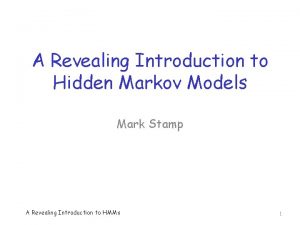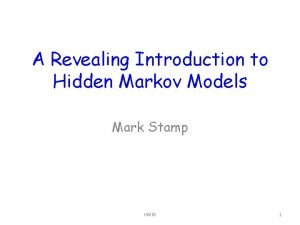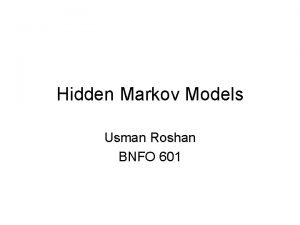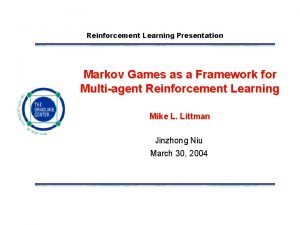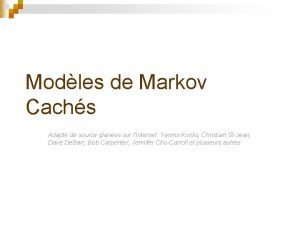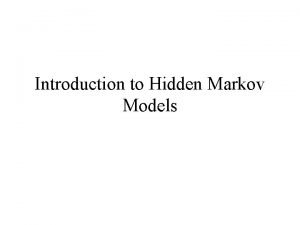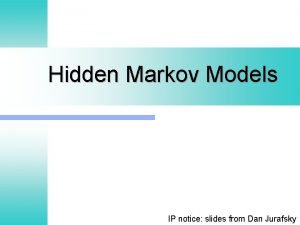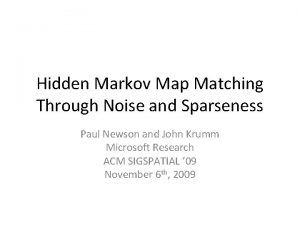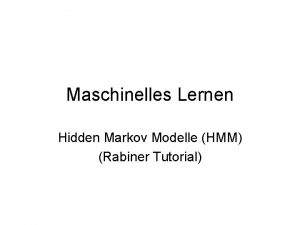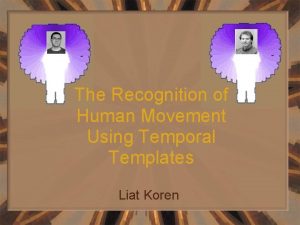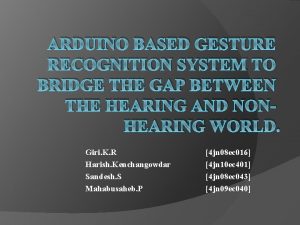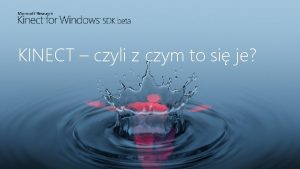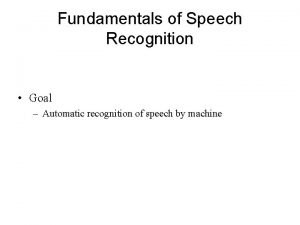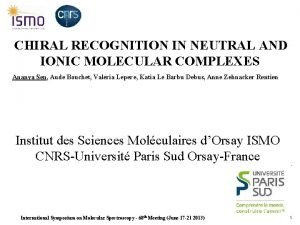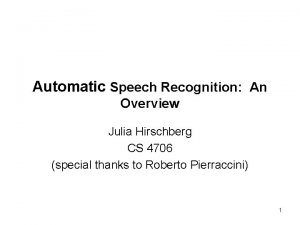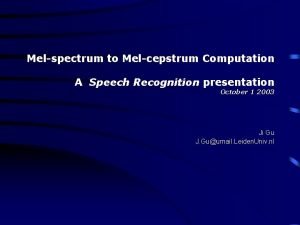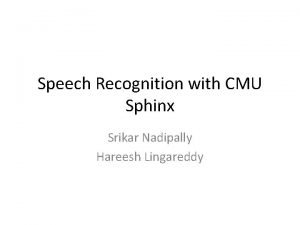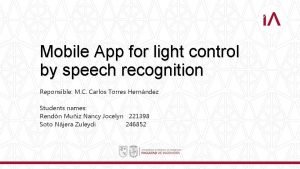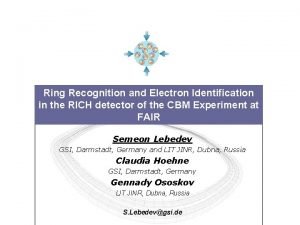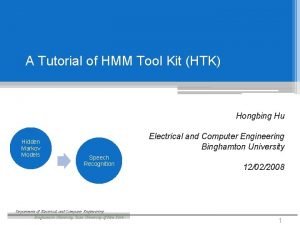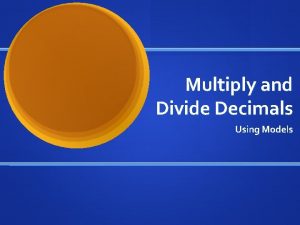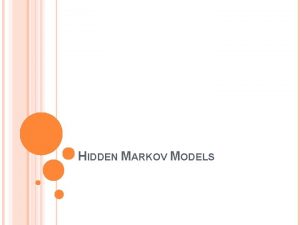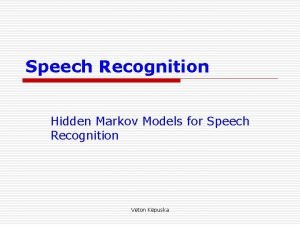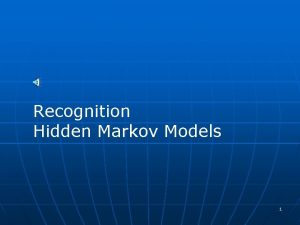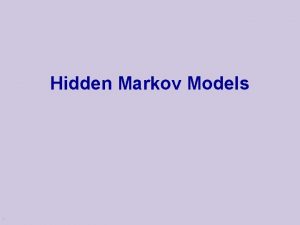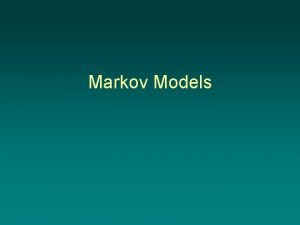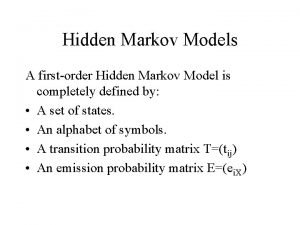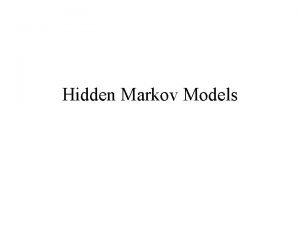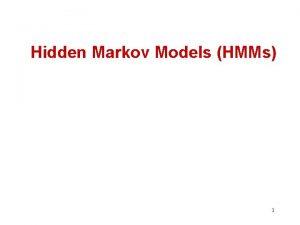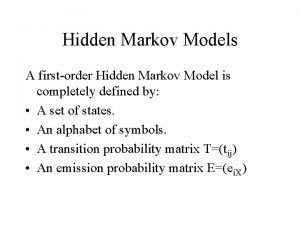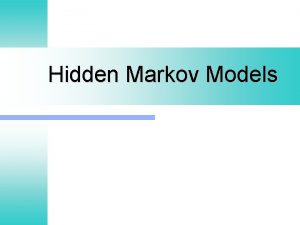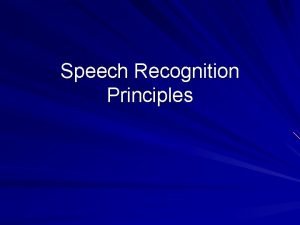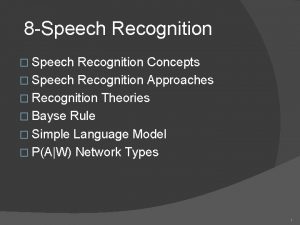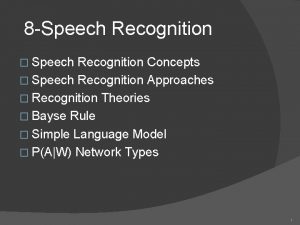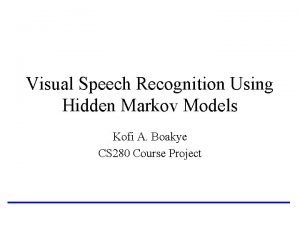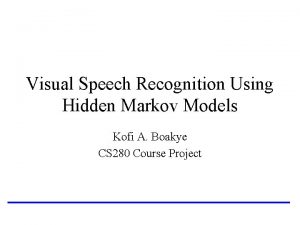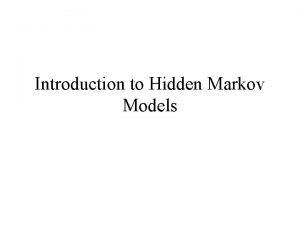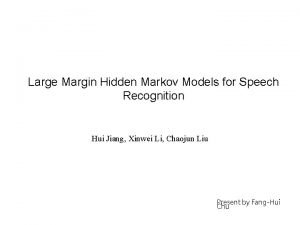IsolatedWord Speech Recognition Using Hidden Markov Models 6

































- Slides: 33

Isolated-Word Speech Recognition Using Hidden Markov Models 6. 962 Week 10 Presentation Irina Medvedev Massachusetts Institute of Technology April 19, 2001

Outline • Markov Processes, Chains, Models • Isolated-Word Speech Recognition Feature Analysis ¤ Unit Matching ¤ Training ¤ Recognition ¤ • Conclusions

Markov Process • The process, x(t), is first-order Markov if, for any set of ordered times, , • The current value of a Markov process depends all of the memory necessary to predict the future • The past does not add any additional information about the future

Markov Process • The transition probability density provides an important statistical description of a Markov process and is defined as • A complete specification of a Markov process consists of • first-order density : • transition density :

Markov Chains • A Markov chain can be used to describe a system which, at any time, belongs to one of N distinct states, • At regularly spaced times, the system may stay in the same state or transition to a different state • State at time t is denoted by qt Fully Connected Markov Model

Markov Chains • The state transition probabilities are made according to a set of probabilities associated with each state • These probabilities are stored in the state transition matrix where N is the number of states in the Markov chain. • The state transition probabilities are and have the properties and

Hidden Markov Models • Hidden Markov Models (HMMs) are used when the states are not observable events. • Instead, the observation is a probabilistic function of the state rather than the state itself • The states are described by a probability model • The HMM is a doubly embedded stochastic process

HMM Example: Coin Toss How do we build an HMM to explain the observed sequence of head and tails? Þ Choose a 2 -state model Þ Several possibilities exist 1 -coin Model: Observable 2 -coin Model: States are Hidden

Hidden Markov Models are characterized by • N, the number of states in the model • A, the state transition matrix • Observation probability distribution state • Initial state distribution, Model Parameter Set:

Left-Right HMM • Can only transition to a higher state or stay in the same state • No-skip constraint allows states to transition only to the next state or remain the same state • Zeros in the state transition matrix represent illegal state transitions 4 -state left-right HMM with no skip transitions

Isolated-Word Speech Recognition • Recognize one word at a time • Assume incoming signal is of the form: silence – speech – silence • Feature Analysis • Training • Unit Matching • Recognition

Feature Analysis • We perform feature analysis to extract observation vectors upon which all processing will be performed • The discrete-time speech signal is discrete Fourier transform with • To reduce the dimensionality of the V-dim speech vector, we use cepstral coefficients, which serve as the feature observation vector for all future processing

Cepstral Coefficients • Feature vectors are cepstral coefficients obtained from the sampled speech vector where is the periodogram estimate of the power spectral density of the speech • We eliminate the zeroth component and keep cepstral coefficients 1 through L-1 • Dimensionality reduction =

Properties of Cepstral Coefficients • Serve to undo the convolution between the pitch and the vocal tract • High-order cepstral components carry speaker dependent pitch information, which is not relevant for speech recognition • Cepstral coefficients are well approximated by a Gaussian probability density function (pdf) • Correlation values of cepstral coefficients are very low

Modeling of Cepstral Coefficients • HMM assumes that the Markovian states generate the cepstral vectors • Each state represents a Gaussian source with mean vector and covariance matrix • Each feature vector of cepstral coefficients can be modeled as a sample vector of an Ldim Gaussian random vector with mean vector and diagonal covariance matrix

Formulation of the Feature Vectors

Unit Matching • Initial Goal: obtain an HMM for each speech recognition unit • Large vocabulary (300 words): recognition units are phonemes • Small-vocabulary (10 words): recognition units are words We will consider an isolated-word speech recognition system for a small vocabulary of M words

Notation • Observation vector is , where each is a cepstral feature vector and is the number of feature vectors in an observation • State Sequence is , where each • State index • Word index • Time index • The term model will be used for both the HMM and the parameter set describing the HMM,

Training • We need to obtain an HMM for each of the M words • The process of building the HMMs is called training • Each HMM is characterized by the number of states, N, and the model parameter set, • Each cepstral feature vector, , in state, modeled by an L-dim Gaussian pdf where is the mean vector and matrix in state , can be is the covariance

Training • A Gaussian pdf is completely characterized by the mean vector and covariance matrix • The model parameter set can be modified to • The training procedure is the same for each word. For convenience, we will drop the subscript from

Building the HMM • To build the HMM, we need to determine the parameter set that maximizes the likelihood of the observation for that word. • Objective: • The double maximization can be performed by optimizing over the state sequence and the model individually

Uniform Segmentation Determining the initial state sequence 50 segments 8 states

Maximization over the Model • Given the initial state sequence, we maximize over the model • The maximization entails estimating the model parameters from the observation given the state sequence • Estimation is performed using the Baum-Welch reestimation formulas

Re-estimation Formulas State transition matrix Mean vector per state Covariance matrix per state Initial state distribution is the number of feature vectors in state

Model Estimation

Maximization over the state sequence • Given the model, we maximize over the state sequence • The probability expression can be rewritten as

Maximization over the state sequence • Applying the logarithm transforms the maximization of a product into a maximization of a sum • We are still looking for the state sequence that maximizes the expression • The optimal state sequence can be determined using the Viterbi algorithm

Trellis Structure of HMMs • Redrawing the HMM as a trellis makes it easy to see the state sequence as a path through the trellis • The optimal state sequence is determined by the Viterbi algorithm as the single best path that maximizes

Training Procedure Uniform Segmentation Cepstral Calculation Estimation of (Baum-Welch) State Sequence Segmentation (Viterbi) No Converged? Yes

Recognition • We have a set of HMMs, one for each word • Objective: Choose the word model that maximizes the probability of the observation given the model (Maximum Likelihood detection rule) • Classifier for observation is • The likelihood can be written as a summation over all state sequences

Recognition • Replace the full likelihood by an approximation that takes into account only the most probable state sequence capable of producing the observation • Treating the most probable state sequence as the best path in the HMM trellis allows us to use the Viterbi algorithm to maximize the above probability • The best-path classifier for observation is

Recognition Cepstral Calculation Select Maximum Index of recognized word

Conclusion • Introduced hidden Markov models • Described process of isolated-word speech recognition ¤ Feature vectors ¤ Unit matching Training ¤ Recognition • Other considerations ¤ Artificial Neural Networks (ANNs) for speech recognition ¤ Hybrid HMM/ANN models ¤ Minimum classification error HMM design
 A revealing introduction to hidden markov models
A revealing introduction to hidden markov models A revealing introduction to hidden markov models
A revealing introduction to hidden markov models Hidden markov models
Hidden markov models Veton kepuska
Veton kepuska Hidden markov model rock paper scissors
Hidden markov model rock paper scissors Hidden markov model tutorial
Hidden markov model tutorial Hidden markov chain
Hidden markov chain Hidden markov chain
Hidden markov chain Hidden markov map matching through noise and sparseness
Hidden markov map matching through noise and sparseness Hmm tutorial
Hmm tutorial Hidden markov model
Hidden markov model Figure of speech simile
Figure of speech simile The recognition of human movement using temporal templates
The recognition of human movement using temporal templates Hand gesture recognition project using arduino
Hand gesture recognition project using arduino Shape matching and object recognition using shape contexts
Shape matching and object recognition using shape contexts Matlab fingerprint recognition
Matlab fingerprint recognition Shape matching and object recognition using shape contexts
Shape matching and object recognition using shape contexts Kinect for windows speech recognition language pack
Kinect for windows speech recognition language pack Fundamentals of speech recognition
Fundamentals of speech recognition Deep learning speech recognition
Deep learning speech recognition Ionic speech recognition
Ionic speech recognition Julia speech recognition
Julia speech recognition Melspectrum
Melspectrum How dyslexic see words
How dyslexic see words Cmu speech recognition
Cmu speech recognition Speech recognition
Speech recognition Speech recognition app inventor
Speech recognition app inventor Dragon speech recognition
Dragon speech recognition Electron speech recognition
Electron speech recognition Htk speech recognition tutorial
Htk speech recognition tutorial What is the difference between models and semi modals
What is the difference between models and semi modals Using recursion in models and decision making
Using recursion in models and decision making Using functions in models and decision making
Using functions in models and decision making Dividing decimals using models
Dividing decimals using models
